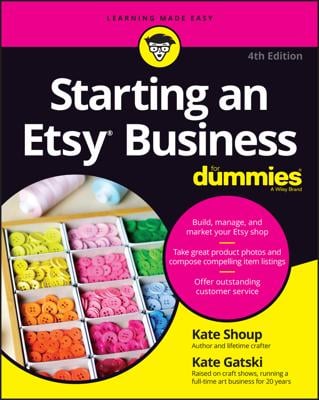When you begin selling items in your Etsy shop, you may wonder how to determine how much your customers should pay for them. If you hope to run a profitable Etsy shop, you need to get comfortable with doing a little math, especially when it comes to pricing your pieces. But don't freak out! All you have to learn are two very simple formulas:
(Materials + Labor + Overhead) x 2 = Wholesale price
Wholesale price x 2 = Retail price
Offering products at different price points (using the preceding formulas) is a great way to increase your customer base. For example, say that you specialize in ceramics. In that case, you may make ceramic mugs to sell at a lower price point; simple, medium-size bowls to sell at a slightly higher price point; and ornate platters to sell at a premium price point. This structure enables you to reach a larger range of potential buyers, which may help you increase your overall sales.
Calculating the cost of materials
When calculating your cost for materials, include the price of every little component in your piece. For example, suppose that you sell handmade puppy plush toys for babies. Your material cost for each pup may include the following:
Fabric
Label
Rickrack
Stuffing
Thread
When you calculate the costs of your materials, you need to consider only the price of what you used to produce one piece. For example, if you bought 3 yards of fabric when purchasing your supplies, for a total of $12, but you used only a third of that fabric to produce a single pup, you want to divide what you paid for the fabric by 3, to calculate your material cost for the fabric — here, $4.
Figuring labor costs
Calculating your labor costs requires you to first set an hourly rate for your time. Be sure to pay yourself a fair wage — one that accounts for the skill required to craft your piece. Also, think about how much you want or need to make for your time. (This consideration is especially important if you're looking to quit your day job.) Many professional crafters go with a rate in the neighborhood of $12 to $20 per hour.
If you're just starting out, you may opt for a lower hourly rate. You can give yourself periodic raises as your skills improve.
Armed with your hourly rate, you're ready to work out your labor costs. These costs must take into account the time it takes to do the following:
Design a piece
Shop for supplies for the piece
Construct the piece
Photograph the piece
Create the item listing for the piece, including composing the item title and description
Package and ship the item
If you clear more than $400 per year with your Etsy shop, you need to pay taxes on it — probably at a rate of about 30 percent.
Adding up overhead
In addition to calculating your costs for materials and labor, you want to account for your overhead. Your overhead may encompass the following:
Tools and equipment used in the manufacture of your products
Office supplies
Packaging supplies
Utilities (for example, your Internet connection, electricity used to power your sewing machine, and so on)
Etsy fees
PayPal fees
These costs don't include shipping. Be sure to calculate those costs separately and pass them along to the buyer.
In the formula provided, after adding your costs for materials, labor, and overhead, you multiply the sum by 2. That "times two" is your profit. It's what you invest back in your business. If your sewing machine breaks, the "times two" is what you use to buy a new one. If you decide to expand your product line, that "times two" is where you find the capital you need to grow. Or you may just use your "times two" revenue to build a nice nest egg for your business or a fund to fall back on if times get tough.

